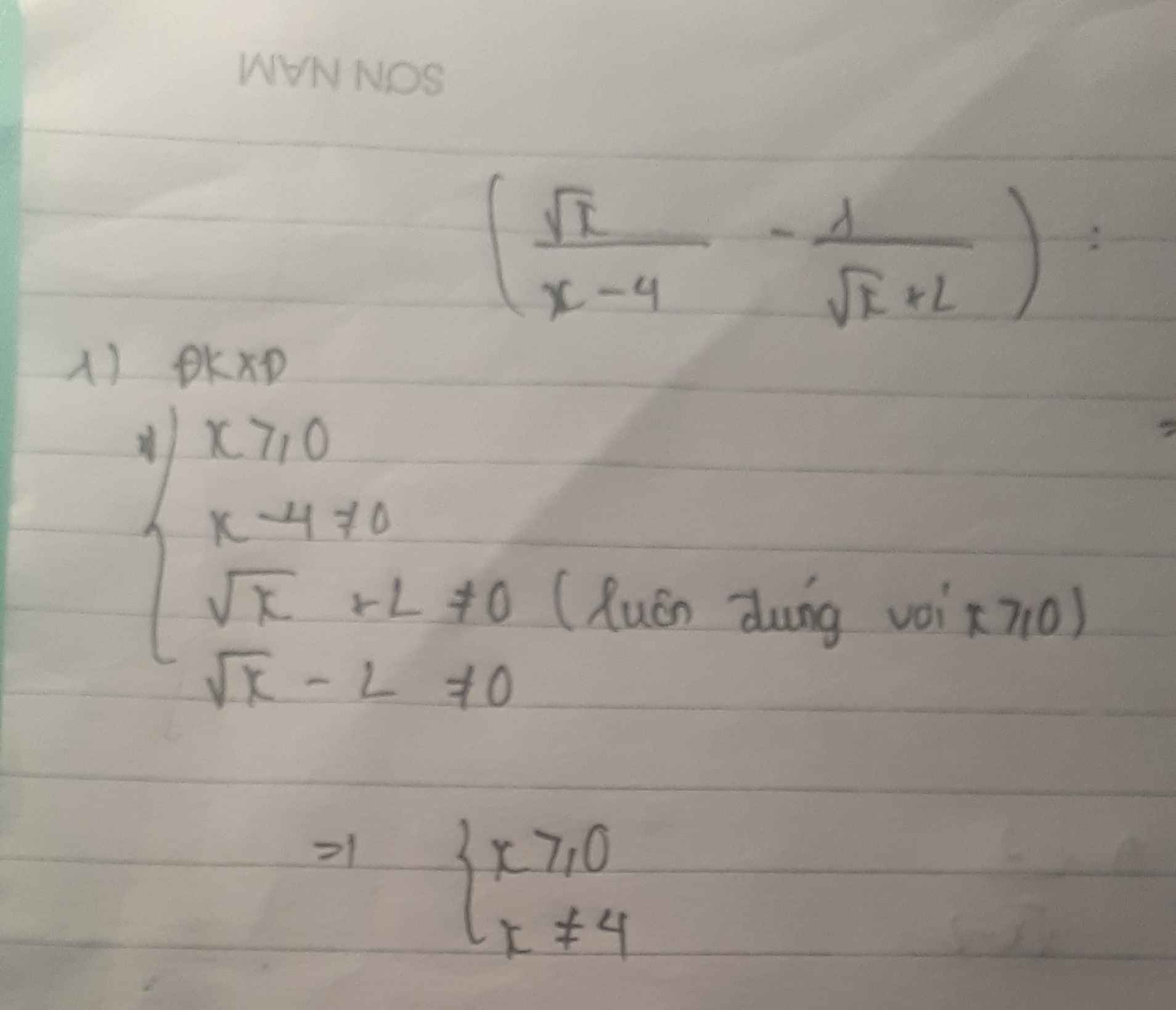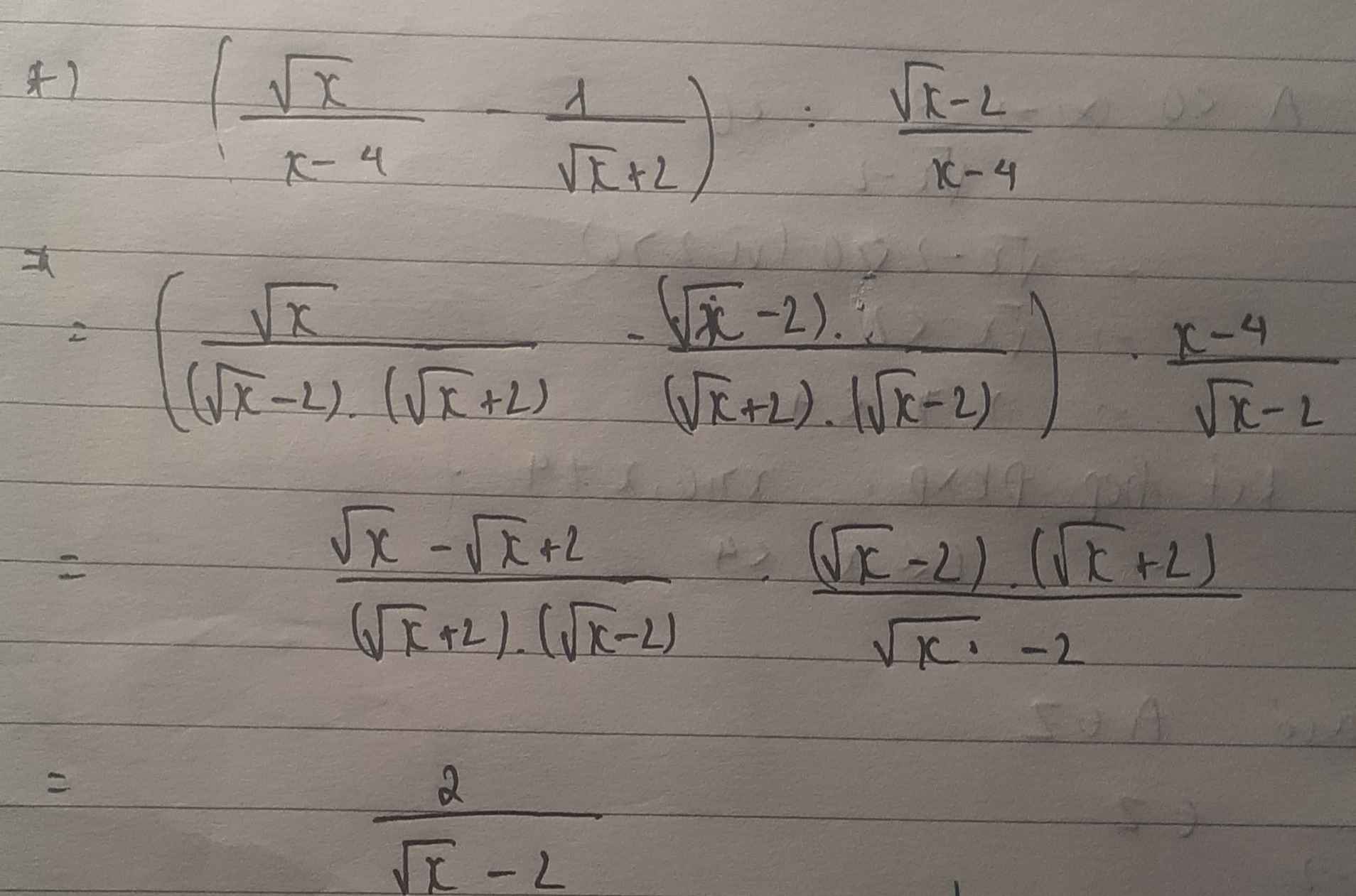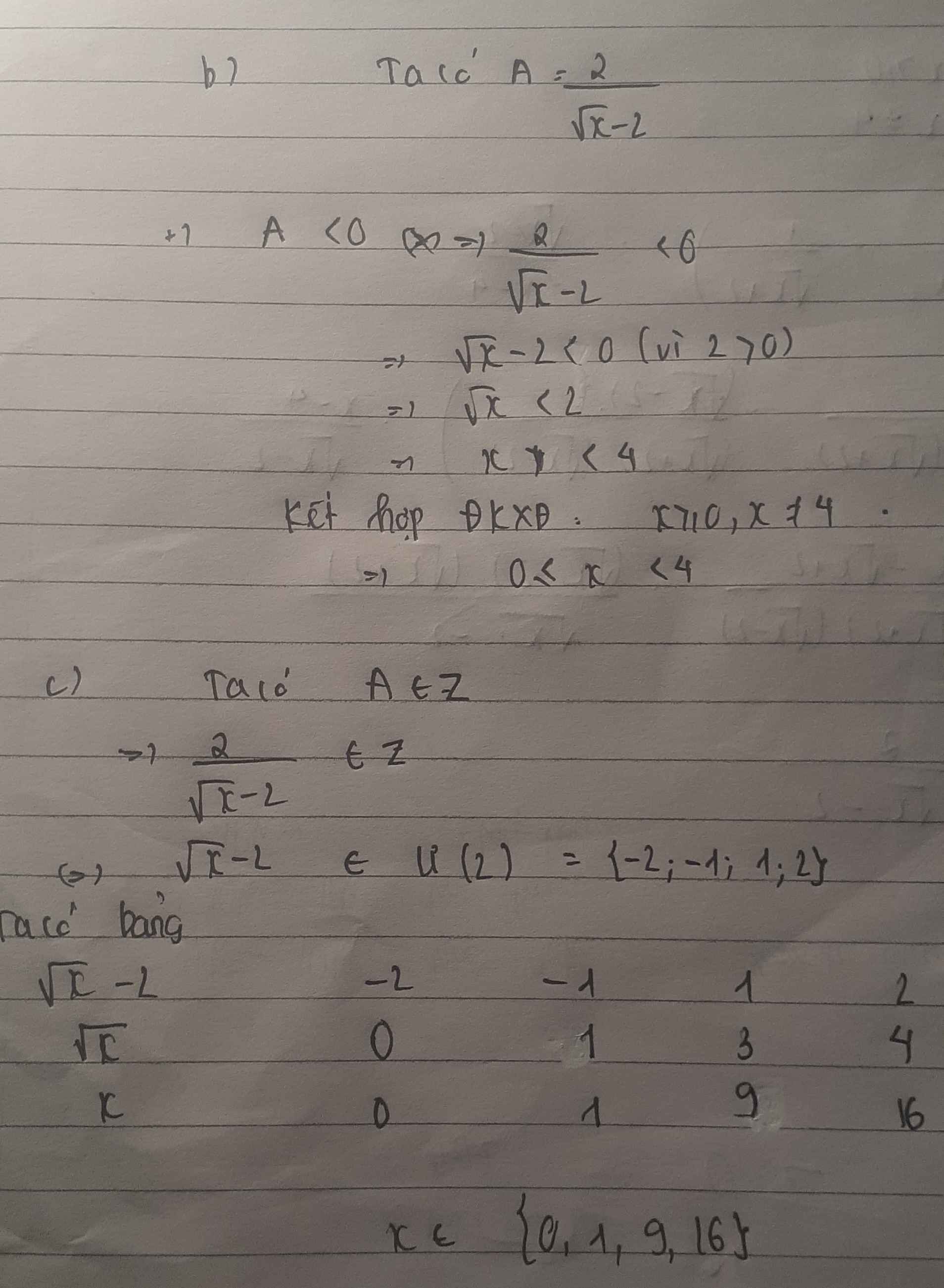
Hãy nhập câu hỏi của bạn vào đây, nếu là tài khoản VIP, bạn sẽ được ưu tiên trả lời.


1) a) Căn thức có nghĩa \(\Leftrightarrow4-2x\ge0\Leftrightarrow2x\le4\Leftrightarrow x\le2\)
b) Thay x = 2 vào biểu thức A, ta được: \(A=\sqrt{4-2.2}=\sqrt{0}=0\)
Thay x = 0 vào biểu thức A, ta được: \(A=\sqrt{4-2.0}=\sqrt{4}=2\)
Thay x = 1 vào biểu thức A, ta được: \(A=\sqrt{4-2.1}=\sqrt{2}\)
Thay x = -6 vào biểu thức A, ta được: \(A=\sqrt{4-2.\left(-6\right)}=\sqrt{16}=4\)
Thay x = -10 vào biểu thức A, ta được: \(A=\sqrt{4-2.\left(-10\right)}=\sqrt{24}=2\sqrt{6}\)
c) \(A=0\Leftrightarrow\sqrt{4-2x}=0\Leftrightarrow4-2x=0\Leftrightarrow x=2\)
\(A=5\Leftrightarrow\sqrt{4-2x}=5\Leftrightarrow4-2x=25\Leftrightarrow x=\frac{-21}{2}\)
\(A=10\Leftrightarrow\sqrt{4-2x}=10\Leftrightarrow4-2x=100\Leftrightarrow x=-48\)

P = A.B = \(\dfrac{x-7}{\sqrt{x}+2}=\dfrac{\left(x-4\right)-3}{\sqrt{x}+2}=\dfrac{\left(\sqrt{x}-2\right).\left(\sqrt{x}+2\right)-3}{\sqrt{x}+2}\)
\(=\sqrt{x}-2-\dfrac{3}{\sqrt{x}+2}\)
\(P\inℤ\) <=> x là số chính phương và \(\dfrac{3}{\sqrt{x}+2}\inℤ\)
mà \(\sqrt{x}+2\ge2\Rightarrow\dfrac{3}{\sqrt{x}+2}\inℤ\Leftrightarrow\sqrt{x}+2=3\)
\(\Leftrightarrow x=1\) (thỏa)
Vậy x = 1 thì P \(\inℤ\)

Lời giải:
a.
\(A=\frac{(x\sqrt{x}-4x)-(\sqrt{x}-4)}{2(\sqrt{x}-4)(\sqrt{x}-2)(\sqrt{x}-1)}\)
ĐKXĐ: \(\left\{\begin{matrix} x\geq 0\\ \sqrt{x}-4\neq 0\\ \sqrt{x}-2\neq 0\\ \sqrt{x}-1\neq 0\end{matrix}\right.\Leftrightarrow \left\{\begin{matrix} x\geq 0\\ x\neq 16\\ x\neq 4\\ x\neq 1\end{matrix}\right.\)
\(A=\frac{x(\sqrt{x}-4)-(\sqrt{x}-4)}{2(\sqrt{x}-4)(\sqrt{2}-2)(\sqrt{x}-1)}=\frac{(x-1)(\sqrt{x}-4)}{2(\sqrt{x}-4)(\sqrt{x}-2)(\sqrt{x}-1)}\)
\(=\frac{(\sqrt{x}-1)(\sqrt{x}+1)(\sqrt{x}-4)}{2(\sqrt{x}-4)(\sqrt{x}-2)(\sqrt{x}-1)}=\frac{\sqrt{x}+1}{2(\sqrt{x}-2)}\)
b.
Với $x$ nguyên, để $A\in\mathbb{Z}$ thì $\sqrt{x}+1\vdots 2(\sqrt{x}-2)}$
$\Rightarrow \sqrt{x}+1\vdots \sqrt{x}-2$
$\Leftrightarrow \sqrt{x}-2+3\vdots \sqrt{x}-2$
$\Leftrightarrow 3\vdots \sqrt{x}-2$
$\Rightarrow \sqrt{x}-2\in\left\{\pm 1;\pm 3\right\}$
$\Rightarrow x\in\left\{1;9;25\right\}$
Thử lại thấy đều thỏa mãn.

a: ĐKXĐ: x>0; x<>1
b: \(A=\dfrac{x+\sqrt{x}-2-x+\sqrt{x}+2}{\left(\sqrt{x}+1\right)^2\left(\sqrt{x}-1\right)}\cdot\dfrac{\sqrt{x}+1}{\sqrt{x}}=\dfrac{2}{x-1}\)
c: A nguyên
=>x-1 thuộc {1;-1;2;-2}
=>x thuộc {2;3}

\(P=\dfrac{B}{A}\\ =\dfrac{\sqrt{x}+2}{\sqrt{x}-1}:\dfrac{\sqrt{x}+2}{\sqrt{x}-3}\\ =\dfrac{\sqrt{x}+2}{\sqrt{x}-1}\cdot\dfrac{\sqrt{x}-3}{\sqrt{x}+2}\\ =\dfrac{\sqrt{x}-3}{\sqrt{x}-1}\\ =\dfrac{\sqrt{x}-1-2}{\sqrt{x}-1}\\ =1-\dfrac{2}{\sqrt{x}-1}\)
Để \(P=\dfrac{B}{A}\) có giá trị nguyên
Thì \(2⋮\left(\sqrt{x}-1\right)\Rightarrow\left(\sqrt{x}-1\right)\inƯ\left(2\right)=\left\{2;-2;1;-1\right\}\)
| \(\sqrt{x}-1\) | 2 | -2 | 1 | -1 |
| \(x\) | 9 | ∅ | 4 | 0 |
| Nhận - Loại | nhận | loại | nhận | nhận |
Vậy \(x\in\left\{9;4;0\right\}\) thì \(x\) nguyên và \(P\) có giá trị nguyên


